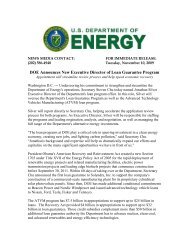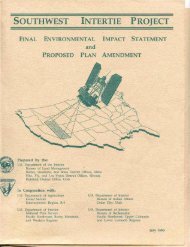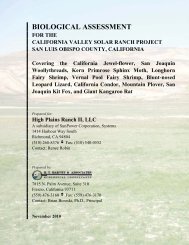Bureau of Land Management's Decision Record and Environmental
Bureau of Land Management's Decision Record and Environmental
Bureau of Land Management's Decision Record and Environmental
Create successful ePaper yourself
Turn your PDF publications into a flip-book with our unique Google optimized e-Paper software.
Jersey Valley Geothermal Development Project<br />
<strong>Environmental</strong> Assessment: NV063 -EAO8-09 1<br />
Though archaeological data <strong>and</strong> theory states that the Western Shoshone (Newe) began to inhabit<br />
the Great Basin area around 600 years ago, contemporary Western Shoshone contend they were<br />
here since “time immemorial.” Social activities that define the culture took place across the<br />
Great Basin. Pine nut gathering, edible <strong>and</strong> medical plant gathering, hunting <strong>and</strong> fishing,<br />
spiritual/ceremonial practices, <strong>and</strong> trade occurred as the Great Basin peoples practiced a mobile<br />
hunting <strong>and</strong> gathering lifestyle. As with the delicate <strong>and</strong> sensitive nature <strong>of</strong> the fragile resources<br />
<strong>of</strong> the Great Basin, the native cultures appeared to be heavily impacted by social, cultural, <strong>and</strong><br />
environmental change, which rapidly accompanied the non-native migration from east to west.<br />
Confined to reservations <strong>and</strong> “encouraged” to participate in a more sedentary lifestyle (farming<br />
<strong>and</strong> cattle ranching), the Western Shoshone <strong>and</strong> other Great Basin tribes continued to practice<br />
certain cultural/spiritual/traditional activities, visited their sacred sites, <strong>and</strong> hunted <strong>and</strong> gathered<br />
the available game <strong>and</strong> medicinal/edible plants. Through oral history, the practice <strong>of</strong> h<strong>and</strong>ing<br />
down knowledge from the elders to the younger generations, many Western Shoshone continue<br />
to maintain a world view not unlike that <strong>of</strong> their ancestors.<br />
Such sites <strong>of</strong> importance include, but are not limited to: existing antelope traps; certain mountain<br />
tops used for prayer; medicinal <strong>and</strong> edible plant gathering locations; prehistoric <strong>and</strong> historic<br />
village sites <strong>and</strong> gravesites; sites associated with creation stories; hot <strong>and</strong> cold springs; material<br />
used for basketry <strong>and</strong> cradle board making; locations <strong>of</strong> stone tools such as points <strong>and</strong> grinding<br />
stones (mono <strong>and</strong> metate); chert <strong>and</strong> obsidian quarries; hunting sites; sweat lodge locations;<br />
locations <strong>of</strong> consistent pine nut harvesting, family gathering, <strong>and</strong> camping; boulders used for<br />
<strong>of</strong>ferings <strong>and</strong> medicine gathering; tribally identified Traditional Cultural Properties (TCP’s);<br />
TCP’s found eligible to the National Register <strong>of</strong> Historic Places; rock shelters; “rock art”<br />
locations; l<strong>and</strong>s that are near, within, or bordering current reservation boundaries; l<strong>and</strong>s included<br />
in tribal l<strong>and</strong> acquisition efforts that involve the Nevada Congressional Delegation, water sources<br />
in general, which are considered the “life blood <strong>of</strong> the Earth <strong>and</strong> all who dwell upon it.”<br />
Specifically, the cultural resources inventory <strong>of</strong> the Jersey Valley Unit Area <strong>and</strong> transmission<br />
line corridor identified ninety-nine archaeological sites (seven <strong>of</strong> which were previously<br />
recorded), including both historic <strong>and</strong> prehistoric resources. Of these, seven have been<br />
recommended by Kautz as eligible for inclusion on the National Register <strong>of</strong> Historic Places<br />
(NRHP), <strong>and</strong> fourteen sites remain unevaluated due to their location in coppice dunes, with the<br />
potential to contain intact, stratified cultural deposits (Kautz 2009) (see also Section 3.3).<br />
In accordance with the National Historic Preservation Act (P.L. 89-665), the National<br />
<strong>Environmental</strong> Policy Act (P.L. 9 1-190), the Federal <strong>L<strong>and</strong></strong> Policy <strong>and</strong> Management Act (P. L.94-<br />
579), the American Indian Religious Freedom Act (P.L. 95-341), the Native American Graves<br />
Protection <strong>and</strong> Repatriation Act (P.L. 101-601) <strong>and</strong> Executive Order 13007, the BLM must also<br />
provide affected tribes an opportunity to comment <strong>and</strong> consult on the proposed Project. BLM<br />
must attempt to limit, reduce, or possibly eliminate any negative impacts to Native American<br />
traditionallcultural/ sites, activities, <strong>and</strong> resources.<br />
The BLM initiated consultation with the following Tribes: Battle Mountain B<strong>and</strong> Council, Te<br />
Moak Tribe <strong>of</strong> Western Shoshonc, Yomba Shoshone Tribe <strong>and</strong> the Duckwater Shoshone Tribe.<br />
To date, the Battle Mountain B<strong>and</strong> has primarily been the most active <strong>and</strong> participating tribal<br />
- 40 -







